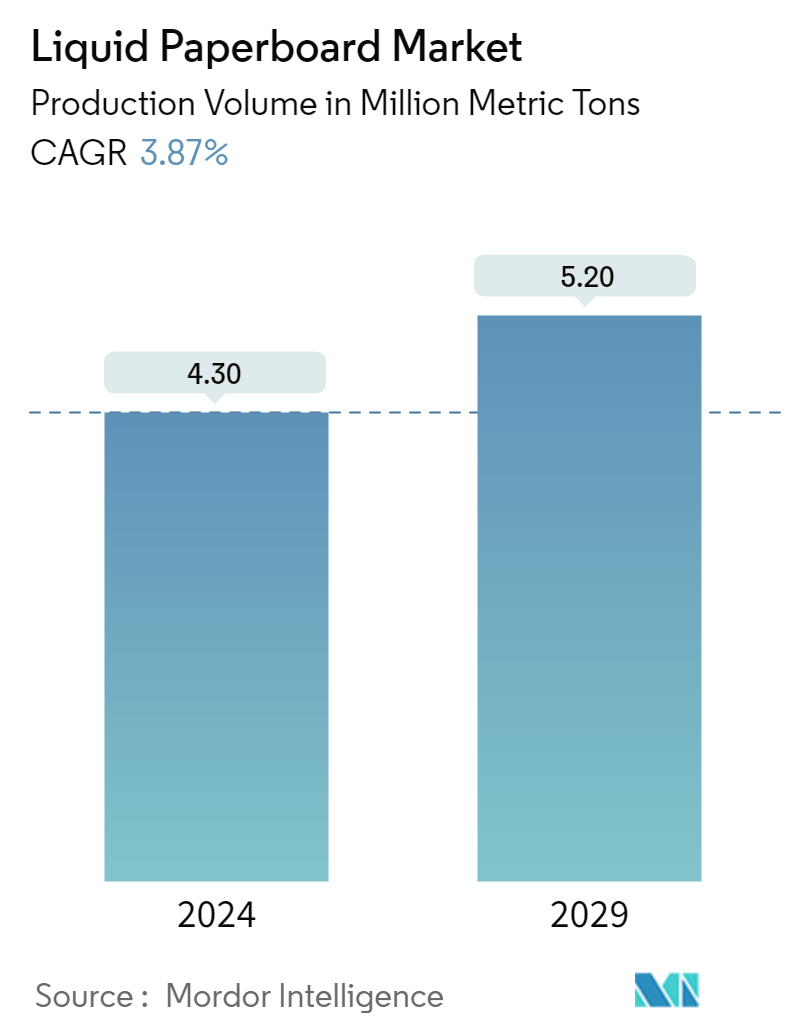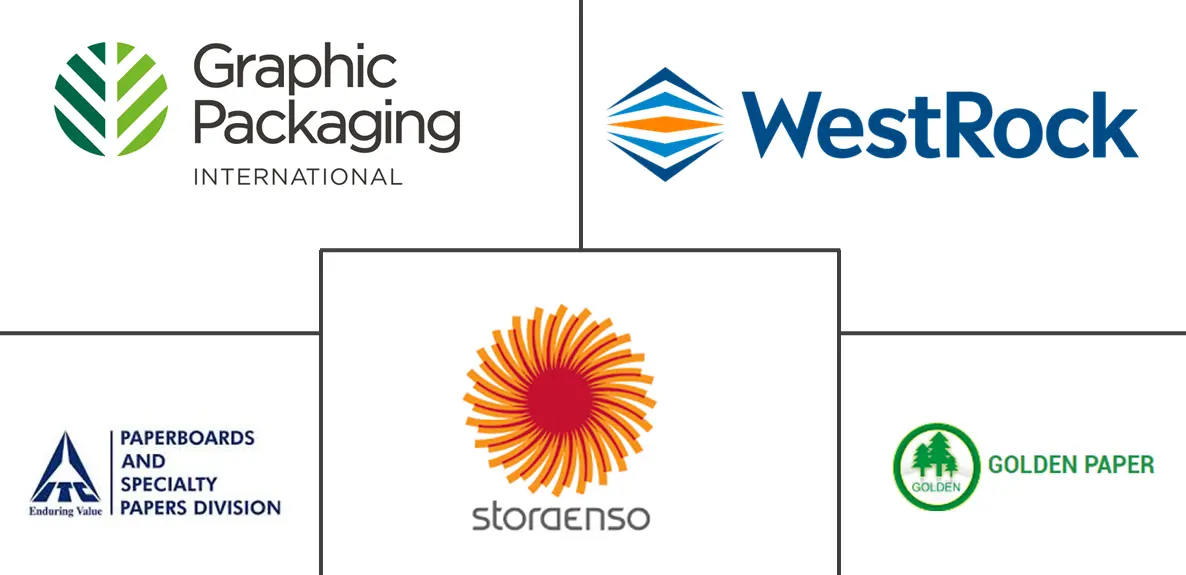Market Size of Liquid Paperboard Industry

| Study Period | 2019 - 2029 |
| Base Year For Estimation | 2023 |
| CAGR (2024 - 2029) | 3.87 % |
| Fastest Growing Market | Asia Pacific |
| Largest Market | Europe |
| Market Concentration | High |
Major Players
*Disclaimer: Major Players sorted in no particular order |
Liquid Paperboard Market Analysis
The Liquid Paperboard Market size in terms of production volume is expected to grow from 4.30 Million metric tons in 2024 to 5.20 Million metric tons by 2029, at a CAGR of 3.87% during the forecast period (2024-2029).
- Liquid paperboard (LPB) is a versatile and sustainable packaging material predominantly used in the food and beverage industry. Liquid paperboard consists of layers coated with various barrier materials, typically polyethylene or other biopolymers, to enhance its protective qualities. This multi-layered structure provides robust physical protection and effective barriers against moisture, oxygen, and light, making it ideal for packaging liquid products like milk, juices, soups, and sauces.
- Liquid paperboard is widely used in packaging for liquid cartons due to its sustainability and barrier properties. Manufacturers employ a minimalist, designable approach to create smaller packs that cater to single servings, reducing material usage and waste. These compact designs enhance convenience for consumers and promote environmental responsibility by minimizing the carbon footprint associated with packaging.
- Technological advancements in barrier coating have been a key driver in developing and enhancing liquid paperboard. Innovative coating technologies, such as those involving bio-based and biodegradable materials, are being developed to improve the performance of LPB while minimizing its environmental impact. These coatings not only enhance the shelf life and quality of the packaged products by preventing contamination and spoilage but also align with the growing consumer and regulatory push for sustainable packaging. For instance, advancements in nanotechnology have enabled the creation of ultra-thin yet highly effective barrier layers that can be applied to LPB, improving its functionality without significantly increasing its weight or cost.
- However, recycling liquid paperboard presents challenges because it is a composite material made from paperboard and polyethylene. Existing recycling infrastructure often needs help to separate these layers, hindering the recycling process efficiently. This complexity necessitates advancements in recycling technologies and systems to effectively handle liquid paperboard and improve its sustainability credentials.
Liquid Paperboard Industry Segmentation
Liquid paperboard combines the strength of paper with the barrier properties of plastic and aluminum to preserve the contents and extend shelf life. The study tracks the demand for liquid packaging boards and food and cupstock serving applications, including food, beverage, nutraceuticals, personal care, and home care. The market study also includes the current import and export regulations on paperboard packaging materials and vendor market share.
The liquid paperboard packaging market is segmented by material type (liquid packaging board, food, and cupstock), end-use application (beverage, food, nutraceuticals, personal care, and home care, and other end-use applications), and geography (North America, Europe, Asia-Pacific, Latin America, and Middle East and Africa). The report offers market forecasts and volume (tonnes) size for all the above segments.
| By Material Type | |
| Liquid Packaging Board | |
| Food and Cupstock |
| By End-Use Application | |
| Beverage | |
| Food | |
| Nutraceuticals | |
| Homecare and Personal Care | |
| Other End-use Applications |
| By Geography | |
| North America | |
| Europe | |
| Asia | |
| Latin America | |
| Middle East and Africa |
Liquid Paperboard Market Size Summary
The liquid paperboard market is poised for significant growth, driven by its increasing application in the food and beverage industry. This versatile and sustainable packaging material is favored for its robust barrier properties, which protect against moisture, oxygen, and light, making it ideal for packaging liquid products such as milk, juices, and sauces. The market is experiencing a shift towards more compact and environmentally responsible packaging solutions, which reduce material usage and waste. Technological advancements in barrier coatings, including the use of bio-based and biodegradable materials, are enhancing the performance of liquid paperboard while aligning with the growing demand for sustainable packaging. Despite challenges in recycling due to its composite nature, ongoing innovations aim to improve the recyclability and sustainability of liquid paperboard.
The European liquid paperboard market is undergoing a transformative shift, driven by a strong emphasis on sustainability and regulatory pressures to reduce single-use plastics. The rise of e-commerce further fuels the demand for durable and eco-friendly packaging solutions, with liquid paperboard offering a compelling option. Market consolidation among key players like Stora Enso, ITC, and Graphic Packaging is facilitating significant investments in research and development, leading to technological advancements such as digital printing and biodegradable coatings. These innovations not only enhance the environmental footprint of liquid paperboard but also expand its applications across various sectors. The market's growth is supported by strategic mergers and acquisitions, as well as initiatives to improve recycling capabilities, reinforcing the material's position as a preferred choice for sustainable packaging solutions.
Liquid Paperboard Market Size - Table of Contents
-
1. MARKET INSIGHTS
-
1.1 Market Overview
-
1.2 Industry Value Chain Analysis
-
1.3 Industry Attractiveness - Porter's Five Forces Analysis
-
1.3.1 Threat of New Entrants
-
1.3.2 Bargaining Power of Buyers
-
1.3.3 Bargaining Power of Suppliers
-
1.3.4 Threat of Substitute Products
-
1.3.5 Intensity of Competitive Rivalry
-
-
1.4 Current Market Scenario For Liquid Paperboard and Liquid Cartons
-
1.4.1 Technological Advancements Leading to Better Barrier Properties and Extended Shelf Life
-
1.4.2 Trend Analysis for Minimalist Designs Resulting in Smaller Beverage Carton Packs
-
1.4.3 International Trade Policies on Import and Export of Paperboard Materials
-
1.4.4 Industry Regulations
-
-
-
2. MARKET SEGMENTATION
-
2.1 By Material Type
-
2.1.1 Liquid Packaging Board
-
2.1.2 Food and Cupstock
-
-
2.2 By End-Use Application
-
2.2.1 Beverage
-
2.2.2 Food
-
2.2.3 Nutraceuticals
-
2.2.4 Homecare and Personal Care
-
2.2.5 Other End-use Applications
-
-
2.3 By Geography
-
2.3.1 North America
-
2.3.2 Europe
-
2.3.3 Asia
-
2.3.4 Latin America
-
2.3.5 Middle East and Africa
-
-
Liquid Paperboard Market Size FAQs
How big is the Liquid Paperboard Market?
The Liquid Paperboard Market size is expected to reach 4.30 million tonnes in 2024 and grow at a CAGR of 3.87% to reach 5.20 million tonnes by 2029.
What is the current Liquid Paperboard Market size?
In 2024, the Liquid Paperboard Market size is expected to reach 4.30 million tonnes.

